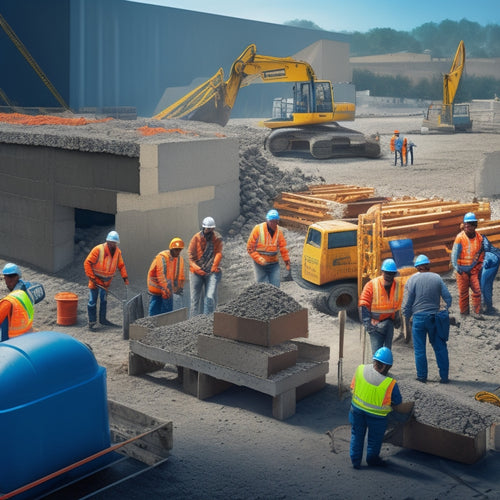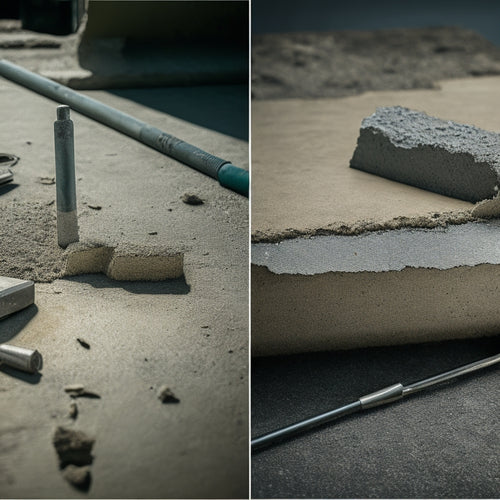
Top Tools for Achieving a Flawless Concrete Finish
Share
When aiming for a flawless concrete finish, you'll need to equip yourself with a range of specialized tools. Essential tamping tools like bull floats, hand tampers, and plate compactors guarantee a smooth, even surface. Precision edging techniques and finishing trowels help create clean lines and a blemish-free finish. Leveling tools, curing compound applicators, and high-quality brooms further enhance the quality of your work. Advanced smoothening tools, such as power trowels and concrete floats, and specialty tools for unique finishes will take your concrete work to the next level. Mastering these tools is just the beginning of achieving a truly exceptional finish, and there's more to explore to get there.
Key Takeaways
• Essential tamping tools like bull floats, hand tampers, and plate compactors ensure a smooth and compacted concrete surface.
• Precision edging techniques with edge control, joint control, and aesthetic enhancement contribute to a flawless concrete finish.
• Proper trowel techniques, including grip, speed, angle, and sweeping motions, help achieve a smooth and even concrete finish.
• Selecting the right finishing trowels with durable blades, comfortable handles, and detachable blades is crucial for a high-quality finish.
• Advanced smoothening tools like power trowels, concrete edgers, and burnishing tools are necessary for achieving a flawless and high-gloss concrete finish.
Essential Tamping Tools for Perfection
You'll typically need three vital tamping tools to achieve a perfect concrete finish: a bull float, a hand tamper, and a plate compactor. Each tool serves a specific purpose in the tamping process, and using them correctly is imperative for a flawless finish.
The bull float helps to level and smooth out the concrete, while the hand tamper is used to compact and densify the material in tight spaces. The plate compactor, on the other hand, provides high-amplitude vibrations to compact the concrete deeply.
To guarantee effective tamping techniques, it's important to maintain your tools properly. Regularly clean and inspect your tools for damage or wear. Store them in a dry, protected area to prevent rust or corrosion.
Additionally, always follow the manufacturer's guidelines for tool maintenance and operation. Proper tool maintenance not only extends the lifespan of your equipment but also safeguards your safety on the job site.
Precision Edging for a Clean Finish
When you're working towards a clean finish, you know that precision edging is essential.
You'll need to master edge control methods to prevent unsightly overflows and achieve a crisp, defined border.
Edge Control Methods
Achieving a clean, precise finish in concrete work relies heavily on effective edge control methods, which enable contractors to create sharp, defined edges and joints that enhance the overall appearance of the final product.
As you work on a concrete project, you'll need to guarantee that your edge finishing techniques are up to par. This involves using the right tools and techniques to control the flow of concrete at the edges, preventing it from spreading or running wild.
Joint control is also essential, as it helps to create clean, sharp joints that don't compromise the structural integrity of the concrete. By implementing proper edge control methods, you can prevent common issues like edge curl, joint spalling, and uneven surfaces.
This not only enhances the aesthetic appeal of the final product but also guarantees a safer working environment by reducing tripping hazards and other safety risks.
Proper Trowel Techniques
Proper trowel techniques are essential for precision edging, as they enable you to create a clean, smooth finish by expertly manipulating the concrete at the edges. A well-executed troweling process guarantees a seamless shift between the concrete and surrounding surfaces, resulting in a professional-looking finish.
To achieve this, focus on the following key techniques:
-
Optimize your trowel grip: Hold the trowel with a firm, but not overly tight, grip, allowing you to maintain control while applying the necessary pressure.
-
Adjust your troweling speed: Vary your speed to suit the specific area you're working on, slowing down for intricate edges and increasing speed for larger surfaces.
-
Maintain a consistent angle: Keep the trowel at a consistent angle to prevent unevenness and guarantee a smooth finish.
- Use gentle, sweeping motions: Apply gentle pressure, using sweeping motions to spread the concrete evenly and avoid creating air pockets or marks.
Top-Notch Finishing Trowels Needed
You'll require at least two high-quality finishing trowels in your arsenal, each with a specific blade design and handle type, to tackle various concrete finishing tasks with precision and efficiency.
When selecting trowels, take into account the materials used. Stainless steel and high-carbon steel blades are ideal for their durability and resistance to corrosion. Fiberglass and aluminum handles provide a comfortable grip and reduce fatigue.
The shape of the trowel is also essential. A rectangular trowel with a curved or 'V' shape is perfect for applying and spreading concrete, while a square-edged trowel is better suited for finishing and smoothing.
You may also want to take into account a trowel with a detachable blade, allowing you to switch between different blade shapes and sizes as needed. Always choose trowels with ergonomic handles and secure grips to prevent accidents and guarantee a safe working environment.
With the right finishing trowels, you'll be able to achieve a flawless concrete finish, free from imperfections and defects.
The Importance of Leveling Tools
When you're working on a concrete finish, you know that achieving a perfectly level surface is essential.
To get it right, you'll need to make certain your slab is properly aligned and that the surface is even from end to end.
Ensure Proper Slab Alignment
Concrete slabs that aren't precisely aligned can lead to costly rework, safety hazards, and compromised structural integrity, making leveling tools an essential component of the finishing process. You must guarantee proper slab alignment to prevent these issues and achieve a flawless concrete finish.
To guarantee proper alignment, you'll need to employ effective slab grading and alignment techniques. Here are some essential steps to follow:
-
Conduct thorough site preparation: Clear the site of debris, vegetation, and obstructions to guarantee a level and even surface.
-
Use precision leveling tools: Invest in high-quality leveling tools, such as laser levels and spirit levels, to guarantee accurate measurements.
-
Check for deviations: Regularly check the slab's alignment during the pouring process to identify and correct any deviations.
- Verify final alignment: Once the concrete has set, verify the slab's final alignment to guarantee it meets the required specifications.
Achieve Perfect Surface Level
With proper slab alignment in place, your focus shifts to achieving a perfect surface level, which hinges on the accurate use of leveling tools to confirm a precise, even finish.
You'll need to employ the right leveling techniques to guarantee that your concrete surface is perfectly horizontal and even. This is vital, as any deviations can lead to uneven settlement, cracks, and other defects that compromise the structural integrity of your concrete.
To achieve a flawless surface, you'll need to invest in high-quality leveling tools, such as laser levels, spirit levels, and screed boards.
These tools enable you to accurately assess and adjust the surface level, confirming that it meets the required specifications. During surface preparation, use these tools to identify and correct any deviations, confirming that your concrete slab is perfectly level and even.
Eliminate High and Low
By accurately detecting and addressing high and low spots, you prevent uneven settlement and guarantee a strong, durable concrete finish. The importance of leveling tools in achieving a flawless concrete finish can't be overstated. These tools enable you to conduct a thorough slope assessment and surface inspection, identifying even the slightest variations in elevation.
To eliminate high and low spots, you'll need the right tools for the job. Here are some essentials to add to your toolkit:
-
Laser Levels: Provide precise, accurate readings to detect even slight deviations in surface elevation.
-
Slope Measuring Devices: Allow for quick and easy slope assessment, ensuring your concrete finish meets required specifications.
-
String Lines: Enable you to create a precise reference point for surface inspection and leveling.
- Concrete Screeds: Facilitate the smoothing and flattening of freshly poured concrete, eliminating high and low spots.
Must-Have Curing Compound Applicators
You'll need a reliable curing compound applicator to secure a uniform, even coat on your freshly poured concrete surface. This is vital, as it directly affects the final finish and overall durability of your concrete.
When selecting an applicator, consider the type of curing compound you're working with, as different applicators are designed for specific compound types. For example, roller-style applicators are ideal for solvent-based compounds, while spray applicators work best with water-based formulas.
Mastering application techniques is equally important. Confirm you're applying the compound at the recommended rate, usually between 100-200 square feet per gallon. Always follow the manufacturer's instructions for application thickness, as excessive buildup can lead to uneven finishes or even delamination.
Additionally, maintain a consistent application pattern to prevent streaks and unevenness. By investing in a high-quality curing compound applicator and honing your application skills, you'll be well on your way to achieving a flawless concrete finish that meets the highest standards of quality and safety.
High-Quality Brooms for Texture
Your broom selection plays an essential role in achieving the desired texture on your freshly poured concrete surface. A high-quality broom can help you achieve a consistent and attractive texture pattern, while a low-quality one can lead to an uneven and unsightly finish.
When choosing a broom, consider the following factors:
-
Broom materials: Look for brooms made from durable, high-quality materials such as nylon, polypropylene, or natural fibers. These materials will withstand the rigors of concrete finishing and provide a consistent texture.
-
Bristle length and stiffness: Choose a broom with bristles that are the right length and stiffness for your specific concrete mix and desired texture pattern.
-
Broom head size and shape: Select a broom with a head size and shape that allows for easy maneuverability and even coverage of your concrete surface.
- Handle material and ergonomics: Opt for a broom with a comfortable, ergonomic handle made from a durable material such as fiberglass or wood.
Advanced Concrete Smoothening Tools
Six advanced concrete smoothening tools are essential for achieving a high-gloss, defect-free finish on your freshly poured concrete surface. You'll need these specialized tools to guarantee a smooth, even finish that's free from imperfections.
First, you'll require a high-powered walk-behind power trowel for initial smoothening. Next, use a ride-on power trowel for larger areas, guaranteeing efficient surface preparation.
A concrete edger will help you achieve a clean, defined edge, while a concrete float will remove any excess material. For a higher-gloss finish, utilize a concrete burnisher or a high-speed burnisher.
Finally, a micro-finisher will give your concrete the ultimate, showroom-quality finish. Remember to always follow the manufacturer's guidelines and take necessary safety precautions when operating these power tools.
Specialty Tools for Unique Finishes
By incorporating specialty tools into your concrete finishing arsenal, you can achieve unique, high-end finishes that reflect your creativity and attention to detail. These tools enable you to create decorative overlays, stamped patterns, and other bespoke designs that set your work apart.
Here are some essential specialty tools to take into account:
-
Stamping mats: These mats feature intricate patterns and designs that can be pressed into freshly poured concrete to create realistic textures and patterns.
-
Texture skins: These flexible skins can be applied to concrete to create unique, organic textures and patterns.
-
Stencil systems: These systems allow you to create custom designs and patterns using stencils and specialized concrete mixes.
- Engraving tools: These tools enable you to engrave patterns, logos, or text into cured concrete, adding an extra layer of detail to your finishes.
When working with these specialty tools, remember to prioritize safety above all else. Wear protective gear, follow manufacturer instructions, and guarantee a clean, well-ventilated workspace to achieve flawless, high-end concrete finishes that exceed your clients' expectations.
Frequently Asked Questions
Can I Use a Regular Broom for Applying Concrete Texture?
When it comes to applying concrete texture, you shouldn't use a regular broom. The bristles can leave behind unwanted marks and compromise the finish.
Instead, invest in a specialized broom designed specifically for texture application. These brooms have stiff, durable bristles that won't leave marks and will help you achieve a uniform texture.
Using the right tool guarantees a professional-looking finish and prevents costly rework.
How Often Should I Clean My Concrete Finishing Tools?
You should clean your concrete finishing tools after every use to prevent concrete buildup and rust.
Develop a routine of tool maintenance to guarantee your equipment stays in top condition.
Implement effective cleaning techniques, such as scrubbing with a wire brush and rinsing with water, to remove stubborn residue.
Regular cleaning will extend the life of your tools, prevent damage, and assure a flawless concrete finish.
Are All Concrete Curing Compounds Compatible With Each Other?
Can you imagine applying a curing compound only to find it reacts with the previous one? Not all concrete curing compounds are compatible with each other, and that's a recipe for disaster.
You need to verify the types of curing compounds you use are compatible to achieve a flawless finish. Always check the manufacturer's instructions and look for compatibility certifications to guarantee a safe and successful application.
What Is the Recommended Temperature for Applying Concrete Sealers?
When applying concrete sealers, you need to take into account the temperature carefully.
Ideally, you should apply sealers when the temperature is between 50°F and 90°F (10°C and 32°C).
Avoid applying sealers in direct sunlight or during extreme temperature fluctuations, as this can affect the sealer's adhesion and performance.
Temperature effects can compromise the sealer's ability to protect the concrete, so make certain to follow the manufacturer's instructions and take necessary precautions to guarantee a successful sealer application.
Can I Achieve a Polished Finish With Hand Tools Only?
You think you can whip out a polished finish with just hand tools? Good luck with that! In reality, achieving a high-gloss finish requires more than just elbow grease.
While hand tool techniques like grinding and honing can get you partway there, they're limited in their ability to produce a truly polished finish.
To take it to the next level, you'll need to master advanced polishing methods, like using progressively finer abrasives and specialized equipment.
Conclusion
You've now got the essential toolkit to achieve a flawless concrete finish. With these high-quality tools, you'll be able to tackle any project with confidence.
Did you know that, according to the American Concrete Institute, a single imperfection in concrete finishing can reduce the structure's lifespan by up to 30%?
By investing in the right tools, you're not only ensuring a flawless finish, but also extending the life of your concrete structures.
Related Posts
-

7 Best Tools for Concrete Block Construction
You'll need a solid foundation, precise cutting, and seamless finishing to guarantee your concrete block construction...
-

Top Mixing Tools for DIY Concrete Block Laying
When it comes to DIY concrete block laying, the right mixing tools are vital for a strong and durable structure. You'...
-

Top Tools for Concrete Adhesion Success
When it comes to concrete adhesion success, you'll need to wield the right tools and techniques to guarantee a strong...


